As a homeschool evaluator in Virginia and a homeschool mom for 20 years, I've worked with hundreds of kids in families who have used all kinds of weekly homeschool schedules.
In this post, I will explain some of the many different types of homeschool schedules that families have successfully implemented, including examples and a template for you to use to create your own.
As you read over the many different ideas below, keep in mind that homeschoolers sometimes find families have to change their approach and their expectations or do things a different way. Adapting to what works best for your family is part of the wonderful flexibility of homeschooling.
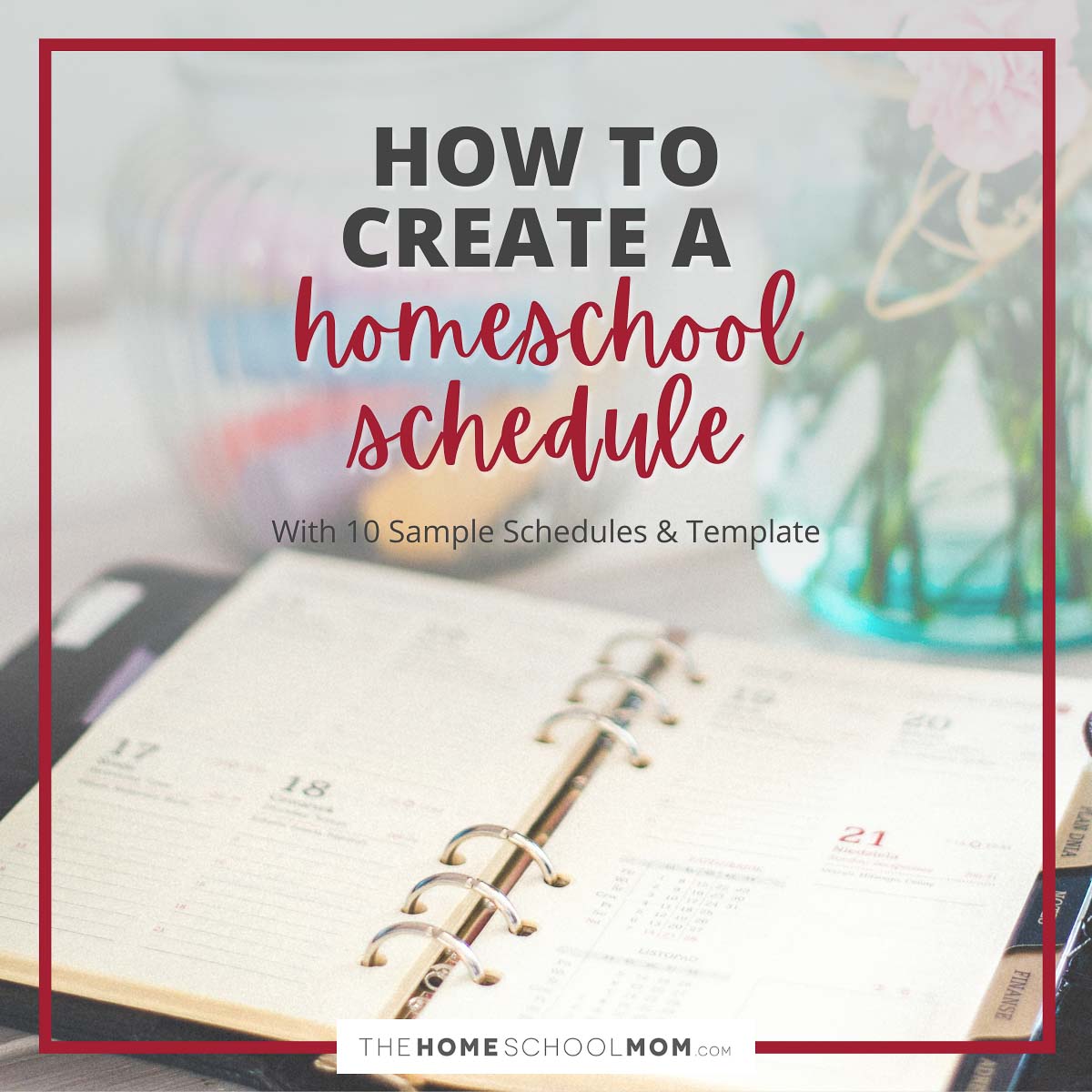
Video: Homeschool Schedules Overview with Jeanne
Tips for Creating a Homeschool Schedule
Creating an effective weekly schedule can look different for each family. Some families have schedules that look like school schedules, but most families use the flexibility of homeschooling to create a weekly schedule that is customized for them. How do you make a homeschool schedule that works?
Here are some tips that will help you to avoid pitfalls as you create your family's schedule.
Tips:
- Start with a broad view of your typical weekly and monthly activities. With a firm grasp of those basic commitments and the needs of your family in mind, you can develop a good plan for an effective homeschool schedule.
- Before you start thinking about your typical homeschool schedule for the week, put your weekly and monthly commitments and kids' activities on the calendar so you can take them into consideration. Then focus on a creating a basic homeschooling schedule for your week around the basic commitments and responsibilities.
- Include your household weekly/daily routine in the basic commitments you include on your calendar. You will need the cushion in your schedule for these non-homeschooling responsibilities.
- Evaluate whether consistency in your daily homeschool schedule is important to you. Some of the options result in each daily schedule being different, while others may look the same each day of the week.
- After deciding on the basic schedule that will work best for your family, keep your initial planning and work assignments to a month or less until you see how the schedule is working for you. If you need to switch gears, you haven't wasted time on schedules that will need to be reworked.
- Do not plan to start off in high gear. Doing too much, too fast, and for too long often results in burnout—your kids' and yours. Instead, invest in the process of deschooling before jumping into a new schedule with both feet.
- Consider starting with one academic subject at a time and adding in more over days or weeks. Many experienced homeschoolers even do this when transitioning to each new school year.
10 Example Schedules & Template Printable
Here are some of the different schedules I have seen work to create a productive homeschooling week. I have included pros and cons for each type of homeschool schedule, and we've put together a free printable with sample homeschool schedules since seeing an example of each schedule type can be helpful.
The Traditional Five-Day Week Schedule
Pros: Works well with pre-planned curricula
Cons: Does not take advantage of the flexibility homeschooling offers
Yes, many follow a homeschool schedule that looks similar to a school schedule, doing five or more academic subjects each day for all five week-days. This can feel familiar, and many curricula make the assumption that this is the schedule you'll follow, so if you're big into pre-planning and use a formal curriculum, the five-day school week may be the schedule for you.
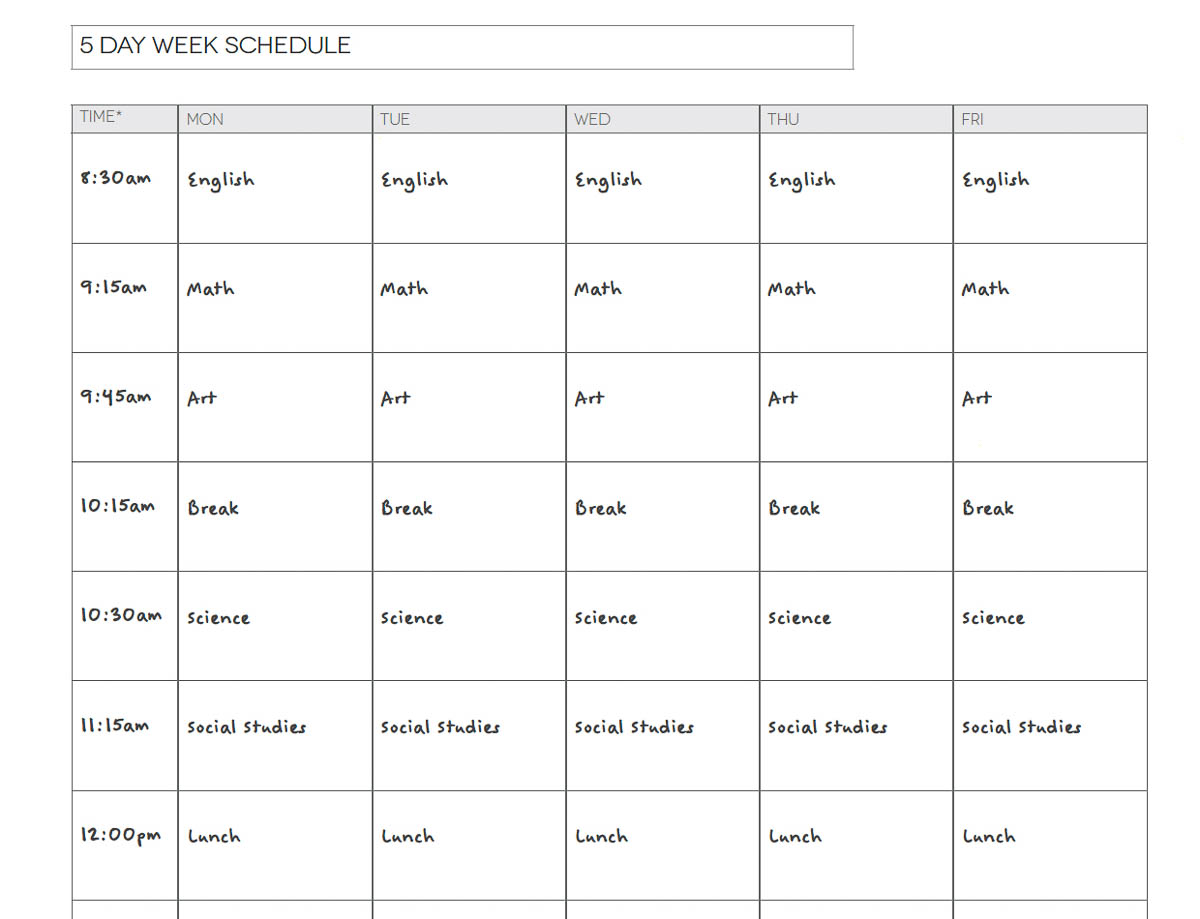
The Four-Day Week Schedule
Pros: Leaves a free day for other activities; the homeschool day closely matches the public school day of other neighborhood kids
Cons: May require adjusting pre-made lesson plans
Some families do traditional academics Monday, Tuesday, Wednesday, and Thursday and leave the fifth day free. This often morphs into "Field Trip Fridays," either as families or members of the same homeschool group or co-op plan field trips for the end of the week. Even though some families may not take a field trip every Friday, they leave that day open for errands, appointments, library day, and a head start on weekend trips. Some curricula offer both four- and five-day plans, built right into their materials.
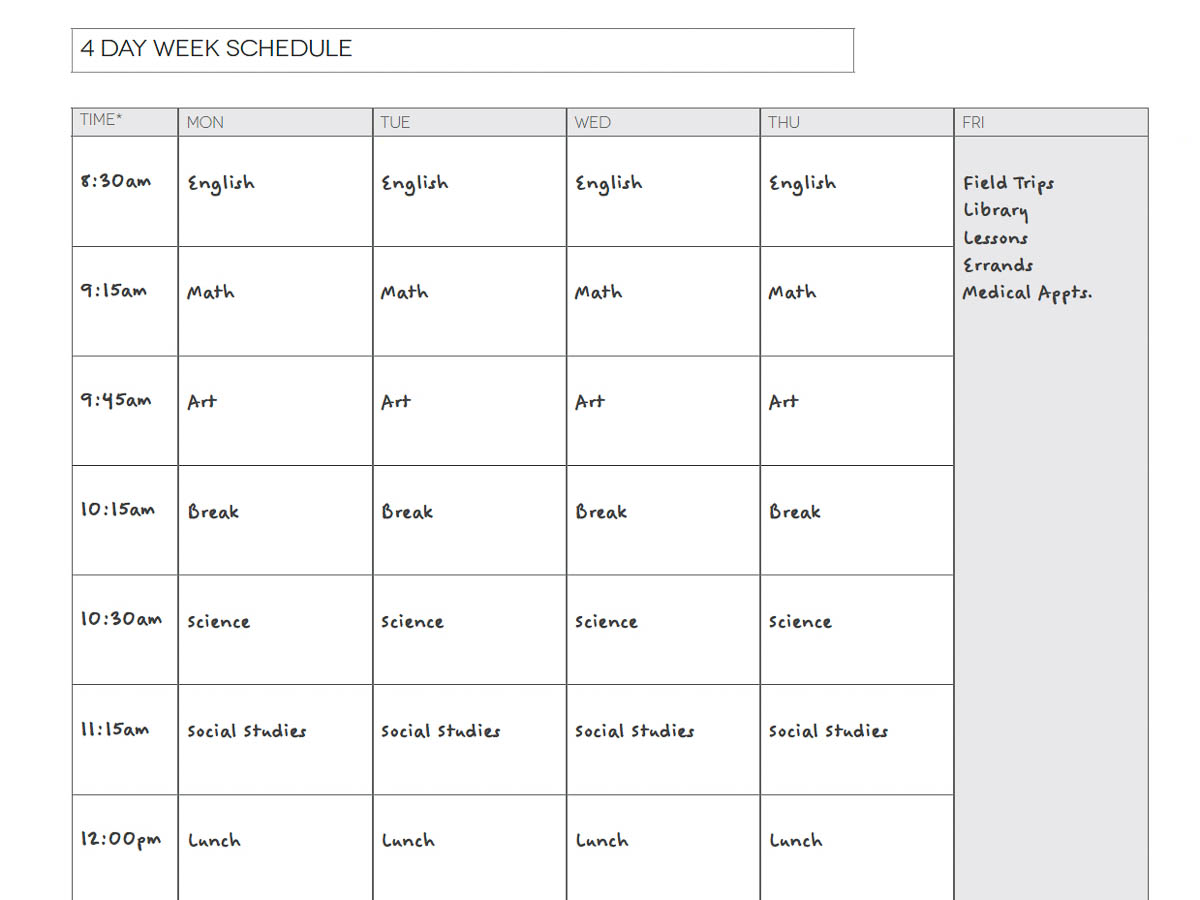
The One-Subject-a-Day Schedule
Pros: Allows more in-depth study and less time refocusing
Cons: May require review due to longer time between covering subject material
Other families divide their learning into traditional school subjects and address one subject each day. For example, they might do math on Mondays, English on Tuesdays, science on Wednesdays, social studies on Thursdays, and electives or "anything else" on Fridays (art, music, foreign language, etc.). The order might vary from family to family, but the idea is to focus on one subject more thoroughly and in-depth on each day.

The One-Subject-a-Day-Plus Schedule
Pros: Allows more in-depth study and less time refocusing but allows for more repetition where needed
Cons: May require review on less frequented subjects; some kids resist repetition of more frequented subjects
The parents and/or kids in families using this type of homeschool schedule like delving deeply into one subject per day, but they also want to do some of certain specific subjects every day. The "plus" is commonly math practice, memory work practice, and/or language arts, so they'll spend time every homeschooling day doing those added ("plus") things, followed by one other subject.
For example, on Mondays they might do math and spelling, followed by science. On Tuesdays they might do math and grammar, followed by history. On Wednesdays they might do math and writing, followed by geography. And so on.
For a younger child, the language arts portion might be a reading lesson or reading practice each day. For a child who wants to write or who needs practice, it might be writing each day.
Memory work, which is an approach some families might take for learning facts like state names and locations, multiplication tables, geologic time periods, or U.S. presidents, is obviously something that works better when revisited frequently.
In any case, homeschool parents using this kind of weekly homeschool schedule may have several things that are done daily because they are seen as the priority or because they are "practice-oriented," while they designate other subjects for each day to give time for real exploration. If science can take up more time on Tuesday instead of switching from subject to subject every 45 minutes to an hour, then you have time to watch a documentary, read a passage, and do an experiment, all related to the same scientific concept. You will be building a lot of context for that science learning all within the same day, making it easier for a child to make connections rather than shifting gears constantly.
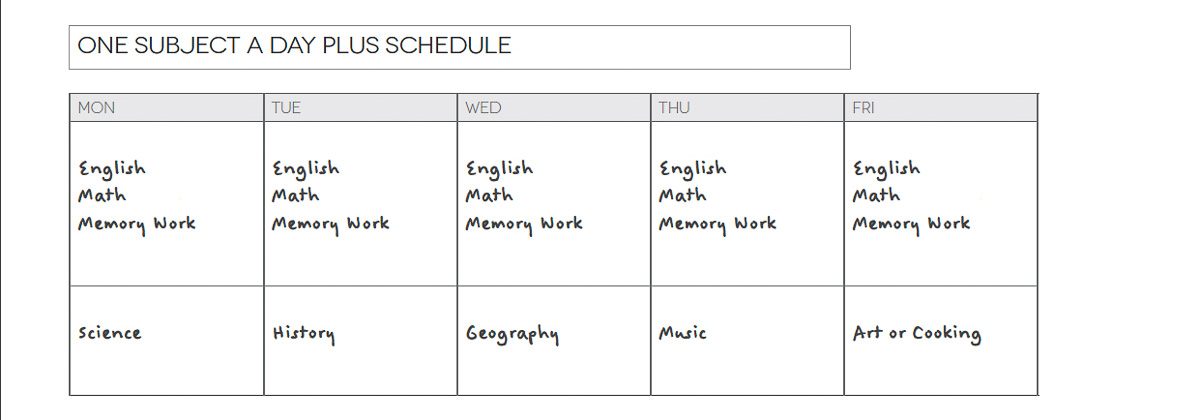
plus some subjects every day
The Co-op-Driven Schedule
Pros: Helps families be more realistic about the amount of time a co-op commitment takes
Cons: Can sometimes squeeze out time at home and relaxed learning opportunities
Some families belong to academic homeschool co-ops that meet on a regular schedule, commonly once per week. While some co-ops are self-contained, with the kids doing enrichment learning at co-op with no expected follow-up, other co-ops have the core academic subjects. Students are expected to do assignments at home and study for tests given by co-op teachers.
Parents will arrange their weekly schedules at home to help their children prepare for the coming classes at co-op. In my homeschooling life, I've been involved in Monday co-ops, Wednesday co-ops, and Thursday co-ops, some of which had homework expectations and some which did not, driven by the type of learning situation my kids wanted. If the co-op has the core academic classes a parent or child wants covered, then other academic interests that are independent of the co-op are also worked in around co-op homework, spread throughout the other days of the week.

The University-Model Schedule
Pros: May cover all subjects with teachers who are experts in their fields
Cons: Not a good fit for kids who are not traditionally academic or have poor executive function skills
In some states, there are university-model homeschool co-ops where classes meet twice a week, using the same type of scheduling you'd commonly find on college campuses. A student might attend four classes on Tuesdays and Thursdays, and have Mondays, Wednesdays, and Fridays to complete homework at home. At other such co-ops, a child might be in the classroom four days a week, with a Monday/Wednesday set of classes and a Tuesday/Thursday set of classes.
Yes, this really does become somewhat more like a private school (and some private schools do operate this way), but in some cases, the kids really aren't there more than several hours per day and don't have access to the kind of comprehensive services that a school offers. Their education continues to be directed by their parents, and there is no official diploma awarded by the co-op.
Obviously, this kind of co-op has a lot of the same kind of scheduling and homework challenges that attending school has. On the other hand, it may give students access to teachers who are more expert in their fields or to a more structured type of learning that they want or that the parent is seeking.
These kinds of co-ops may sound like a dream come true for someone who has recently taken a child out of school in order to homeschool ("They cover all the subjects!"), but don't be fooled; using a co-op as a replacement for school does not always work well, especially immediately following withdrawing from school. Instead, consider deschooling first.
Some families use this kind of block scheduling at home without attending a University-Model school. Implementing this model at home is more flexible for students who are not working on the same grade level in all subjects and for families who like the block scheduling but don't want to (or can't) participate in a co-op.

The Shift-Work Schedule
Pros: Can tag team homeschooling between parents; kids see more of their employed parent(s)
Cons: Odd schedules can make sports, activities, and social time more difficult to arrange; hard to homeschool when neighbor kids want to play after their school
Some families have a parent who is working a more unusual shift or schedule, such as a hospital nurse or a firefighter who works three or four days on with three or four days off. Homeschooling can be coordinated to take place while the parent is working -- if the other parent is an at-home parent doing the homeschooling. This way time off can be maximized with togetherness rather than worries about academics.
Another approach may be scheduling the academics purposely during the off shift. This way, in a two-parent family, both parents can participate in the homeschooling, or in a single-parent family, the homeschooling can take place during time off with child care covering the work hours.
You can definitely create a homeschool schedule that takes your work schedule into account.
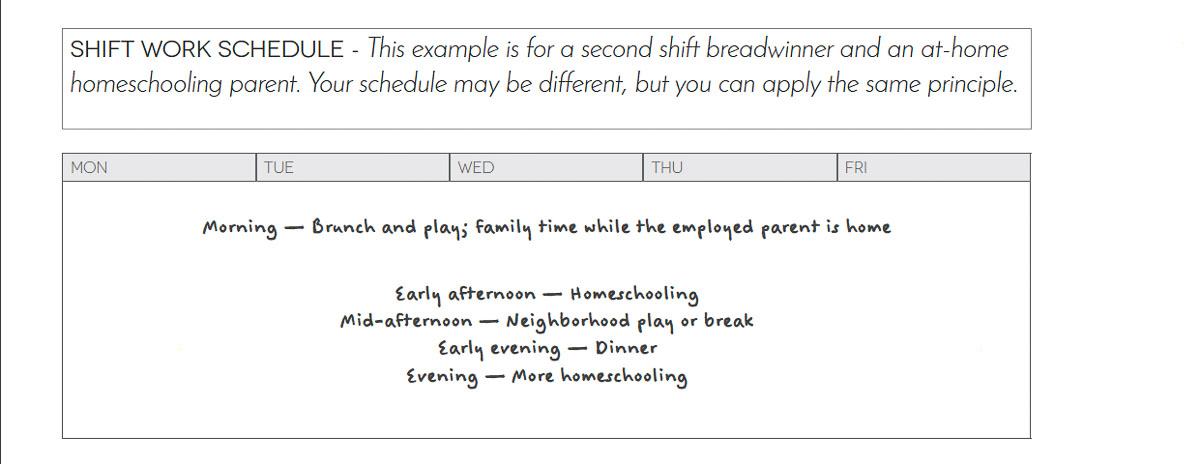
The Extracurricular and Class-Driven Schedule
Pros: Can increase commitment to specific priorities like sports or a special class
Cons: Easy to over-schedule and leave too little time at home
In a large or busy family, extracurricular activities, sports, volunteering, and classes in the community go on the weekly schedule first. For example, the local science museum may be offering an eight-week class in archaeology on Tuesdays, and all three kids go for piano lessons on Thursdays, followed by library story hour. Fridays may be the day that your family volunteers at the animal shelter or at the food pantry.
Families who make liberal use of these kinds of resources work other academics around these outside activities. I have known many families who have found that their kids took off with Scouts and 4-H projects to the extent that they actually became a large part of their academic learning, so prioritizing them made sense.
Just as a matter of practicality, outside activities aren't going to bend to your personal schedule unless you are the organizer, so putting outside commitments on the calendar first is just a reality, especially as children get older.
Sometimes the "other things" on the calendar really do drive your homeschool schedule, and that's okay!
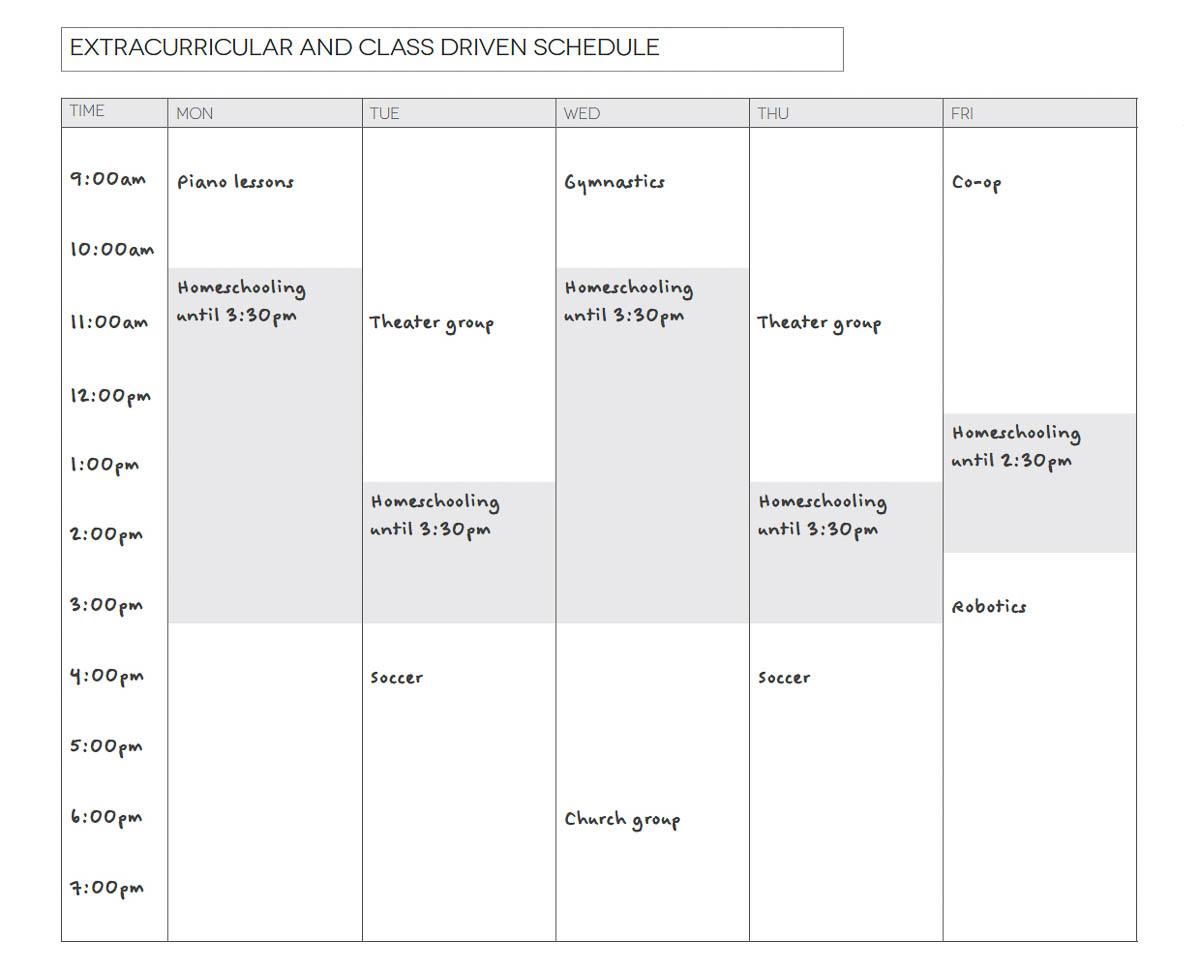
The What-We-Need-to-Do and What-We-Want-to-Do Schedule
Pros: May help develop executive function, planning skills, and creativity if parent partners with child or teen
Cons: May be easy to leave kids on their own without resources they need for their studies and projects
Families who use project-based homeschooling, interest-based homeschooling, unschooling, unit studies, and interdisciplinary homeschooling may not find school subjects or community activities to be the most compelling aspects of their weekly schedule. Instead, their homeschooling may revolve around where the project or interest or study leads. Their days of the week are organized around what they need and want to do to follow up on interests or projects.
That might mean a day at home to research and plan and make lists. This might be followed by a day out to shop for supplies and materials. Then a day at home to build and create the project, along with more list-making and research for another round of resource-gathering. There might need to be a day to visit with a mentor or go to the library for books, or a day to wait for help from Dad or Aunt Janie.
Homeschooling parents using one of these approaches may keep their weekly schedules fluid and ever-changing with each project, or they may have designated days that they know they will "stay home" or "be out," and they tack on what is needed for the week's learning to certain days. That way, material gathering will always be done on Tuesdays -- a designated "out" day, while kids can look forward to help and undisturbed time for working on projects on Wednesday -- a designated "home" day.
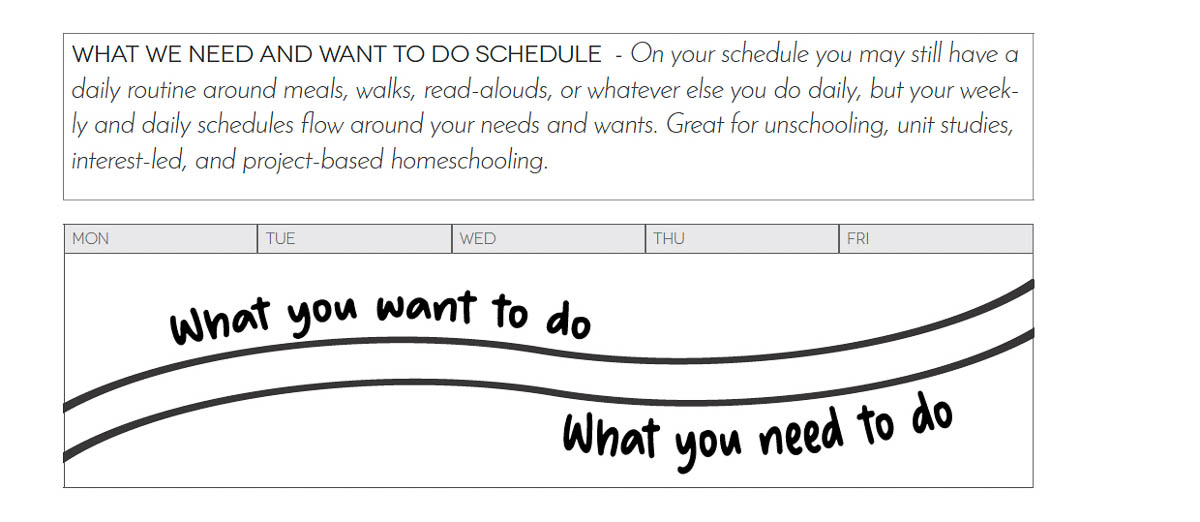
The Alternating Home/Out Schedule
Pros: Balances time at home with time going to classes, sports, co-op, and errands
Cons: Outside activities may not fit your out days; packing so much into "out" days is challenging with babies and young children
In fact, many homeschooling families, especially those with young children, find that a mainstay of organizing their homeschool schedules is that alternating pattern of home- and out-days. A big day of errands, lessons, grocery shopping and volunteering needs to be followed by a slower paced home-based day to give everyone time to recover and have time for reading, playing, exploring, and helping with home maintenance. This may especially be true for people living where there are a lot of activities available to homeschoolers, so they have to be careful not to over-schedule.
However, it can also be a wise rhythm for families who live in rural areas who have to drive long distances to activities: scheduling firm home days can be a relief from being in the car too much and valuing outside activities over home-based ones.
The home/out alternating schedule also provides relief for both your extroverted children and introverted children -- who can look forward to having time to recharge with the level of interaction that helps them function best.

Homeschool Schedule FAQs
How do I create a homeschool schedule?
- Put high priority weekly and monthly activities on a weekly schedule worksheet first—things like library days, homeschool co-op, music lessons, sports practices, and grocery day.
- Consider grouping some regular “out-of-the-house” activities on the same day.
- Look at days without outside activities and the time between commitments.Those days and those blocks of time are the time you can help your child learn at home.
- If you are using curriculum, space lessons out in the available time, leaving time for meals and breaks. If you are using an interest-led or project-based approach, you’ll want a more fluid schedule that includes time to gather resources or meet with mentors.
- If shift work and employment are part of your picture, you’ll account for work schedules, so you can homeschool around work commitments.
We have example schedules in this post for many different scenarios, and our free printable with example homeschool schedules includes blank worksheets you can customize with your activities.
How many hours a day should I spend homeschooling?
There are two factors when deciding how long to homeschool each day: what’s effective and what’s required.
Most states do not have any required hours while a few states require homeschooling parents to log hours in writing. Homeschoolers in your state can give you tips for meeting requirements. If it’s not required in your state, you do not need to meet a certain number of hours “just in case,” and your homeschool day does not need to look like a school day.
Remember, you aren’t teaching a large “class” of students, and your children are also learning when you are not actively teaching. You may formally work with a kindergartener or first grader for an hour, spread out during several parts of the day because of short attention spans.
A six year old may have an attention span as short as eight to ten minutes! But lots of things count: following a recipe while cooking with Mom or Dad, listening to a bedtime story, watching a dinosaur documentary, gathering wild flowers and talking about how they need sun, earth, and rain to grow.
As kids grow older, homeschooling can expand to fill more hours of the day. Remember that insisting on completion of a lesson, chapter, or complete problem set may not be as effective as stopping after a certain amount of understanding or effort. You’re homeschooling—you can meet the needs of your child rather than your curriculum.
How many days a week should I homeschool?
Homeschool for the number of days each week that creates a positive experience for you and your kids.
Many curricula assume five days a week or have a second option for four days a week. However, you can spread lessons over more or fewer days depending on what works for your family. This may vary from year to year and even from child to child and subject to subject!
Some homeschoolers homeschool year round and don’t worry about a certain number of days each week. Some homeschoolers do not separate “homeschooling days” from “non-homeschooling days,” since learning happens all the time. That five-day-a-week “schedule” originates with schools rather than families and may not apply to your family. That’s especially true if you’re using resources rather than a paced curriculum or if you are homeschooling through projects or your child’s interests.
Check your state law to see if there are requirements for tracking hours or days of homeschooling, and learn how homeschoolers in your area meet the requirement. There is often more flexibility than you expect.
What does a homeschool day look like?
While many families start with a schedule planned to the clock, a flexible approach is to start with a rhythm or routine, often organized around meals, snacks, the baby’s naps, afternoon walks, or other “anchors” to the day you choose. This way, you and the children always know, after breakfast, you gather to read aloud and have “morning time” discussions. Then math. After math, a snack and time to walk the dog. Then a music listening activity or science documentary during lunch, and so on.
Homeschool days vary so much depending on the ages of children in the family, how many outside activities they are involved in, and whether parents are employed outside the home. One family’s days may involve theater rehearsal twice a week at 1 pm. Another family may do farm chores before breakfast.
While some parents structure their days so all homeschooling is done in one block, other parents may discover that after 45 minutes of concentration, the kids do better if they play outside for an hour and then resume homeschooling. If you could peek into the homes of a hundred different homeschooling families, you’d see a hundred different homeschool days, most looking not very much like school schedules. You can structure your homeschool day so it works for you and the kids.
How do I loop a schedule for homeschooling?
To create a loop schedule, list all the homeschool subjects and activities you’re planning to do. Begin with the top item on the list, and then spend time each day working on “what’s next” on the list.
If you get through three subjects on Monday, then on Tuesday, begin with the fourth subject on the list. Perhaps you get through just two things that day, so on Wednesday, start with the sixth item, and so on. When you get to the end of the list, loop back to the beginning, no matter what day it is.
You can have “repeats” in your list intentionally, so you hit those activities or lessons more often. You can also mix and match looping with one of the other approaches to scheduling. Commonly, parents might do math and language arts every day, but create a list of looped studies or practices for history, science, music, art and interest-led learning.
Looping might be activity-based rather than subject-based, too. Instead of listing English, math, science, history and so on, you might list activities such as read aloud, nature walk, handcraft/art, project time, etc.
You can fit “what’s next” on your looping list into specific hours of the day (which gives you a good stopping time each day), or you can keep your hours open ended so you stay with a project that is engaging the kids, knowing you can pick up on other priorities on a different day. Start with the next thing on your list!
The Effective Homeschool Schedule
The truth is, most homeschooling parents have to consider many of these things in creating a strong homeschool schedule for their week.
They may participate in a co-op, have regularly scheduled outside activities, do shift work, and use a curriculum alongside interest-based learning and projects. Or, they may be unschoolers whose kids nonetheless participate in a co-op and a lot of community activities, service work, and time with mentors.
Everyone also has to figure in time for grocery shopping, meal preparation, laundry, home maintenance, and appointments, and many have to include part-time or full-time work.
An effective homeschool schedule takes these things into consideration, along with time for the student to do independent work and for the homeschooling parent(s) to take a break and pursue their own interests.
You might find some kind of weekly planner to be a useful tool in scheduling your homeschooling and as something you can post on the fridge to keep your whole family aware of the regularly occurring weekly events (TheHomeSchoolMom has a free homeschool planner here).
In any case, thinking not only about your homeschool year but also your weekly homeschool schedule can be valuable in preparing for your upcoming season of homeschooling. Rest assured that not everyone follows a school pattern for their homeschool schedule, and you can flex your week to meet your family's needs—and your own.




 A popular speaker at homeschooling conferences, business groups, and parents’ groups, Jeanne Potts Faulconer homeschooled her three sons in North Carolina, Mississippi, and Virginia for twenty years. Holding her Master of Arts degree in Communication, Jeanne conducted portfolio evaluations for Virginia homeschoolers for evidence of progress for many years. Jeanne is a former college faculty member, former editor for several publications, news correspondent for WCVE, and former director of Brave Learner Home. She is the contributing editor for TheHomeSchoolMom newsletter and writes the popular Ask Jeanne column addressing homeschool parents' questions here at TheHomeSchoolMom.
A popular speaker at homeschooling conferences, business groups, and parents’ groups, Jeanne Potts Faulconer homeschooled her three sons in North Carolina, Mississippi, and Virginia for twenty years. Holding her Master of Arts degree in Communication, Jeanne conducted portfolio evaluations for Virginia homeschoolers for evidence of progress for many years. Jeanne is a former college faculty member, former editor for several publications, news correspondent for WCVE, and former director of Brave Learner Home. She is the contributing editor for TheHomeSchoolMom newsletter and writes the popular Ask Jeanne column addressing homeschool parents' questions here at TheHomeSchoolMom.
Thank you for all this information. I have been a high school certified math teacher for over 20 years. I have also taught K-12 grade in various other subjects. I decided this year not to return to the classroom. I have been asked by a family member if I would consider homeschooling their 3 year old. I am considering this. The idea of homeschooling has always interested me but my hubby was not on board with it when our children were younger. I have learned a lot from your website but I am apprehensive about taking this on.
Do you have information or advice in regards to homeschooling someone else's child. What are some pros and cons?
Homeschooling someone else's child may or may not be legal in your state, so that's the first thing to figure out. And, it may be legal in some states when conducted by a certified teacher like you. This article, Can Somebody Homeschool My Kids? will have more relevant information for you.
Keep in mind that you may be able to "homeschool" a child before compulsory attendance age without any special laws coming into play other than those that may be in place for child care.
Best of luck,
Jeanne
Wow! This is incredible. I'm homeschooling my 3rd child - my other two are homeschool graduates now. Even though I've been through this twice before - this is soo helpful! Child #3 has some medical issues so her schooling is a little more challenging. Thank you for sharing! You made my day!
It always helps to see examples of how various families are working out homeschool schedules, doesn't it? So glad you have found this helpful. Yes, even though you've been through it before, you're still revisiting the basic challenges of homeschooling, especially with those added medical issues.
Thanks for letting us know we made your day. That makes our day!
Jeanne
What about a 2 subject a day schedule? Monday to Friday, then Saturday Physical Education? What are the pros and cons? I was planning 2 hours a day, since I work from 1:30pm to 5:30pm so it would be from 6pm to 8pm. My son is 3 years old, he's very physical, easily distracted unless I put his hands on something, then he pay attention, hyper and speech delayed, taking speech/occupational therapy on mornings, I'm a book freak, I prefer planned things, checklists, organization, etc.
Questions:
-What are the pros and cons of 2 subjects a day schedule?
-Can I make it work for my boy needs (Speech delay, kinesthetic learner)?
-Will we crash together as a textbooks freak, organized, schedule mom vs kinesthetic learner, hyper, speech delayed kid?
Two subjects a day will work if it works for YOU and for your CHILD. That is the most important aspect of any homeschool schedule.
The "cons" with a 3 year old are mainly related to attention span and developmental stage. I would expect most 3s to pay attention to an adult agenda for about 5 or 6 minutes with a break for 30 minutes to an hour for play. Yes, if you are trying to use textbooks and if you are inflexible about lesson times with a 3 yo, you may find challenges in making that work.
Many 3s are kinesthetic and easily distracted, which is developmentally appropriate for that stage, so it's not just your kiddo. For preschool (and honestly for a lot of kids well beyond that stage), I like to recommend that parents think of using a routine rather than a strict schedule, so that parent and child can have expectations about the ways their days usually progress—but without an inflexible schedule that is unrealistic for such young children.
Remember to claim the "book freak" aspect of yourself as your OWN without feeling it necessary to apply it to your 3 yo, who may or may not grow into the same proclivity you have!
And look for your child's responses to guide you in what is working. A young child who engages is showing you what works. A young child who resists is showing you what doesn't work. The goal of any routine or schedule should be to cultivate those moments of engage them and then "quit while you are ahead," before going on "too long" accidentally creates resistance. That's because with a 3, your primary goal should be helping them begin to love learning. Extra lessons that are taking place without engagement because of a "schedule" will create negative associations with learning.
Watch your child, not the clock!
Good luck!
Looking forward,
Jeanne
Great article. Detailed and simplified for first time homeschoolers looking for schedule options to explore for their homeschool.
I'm glad you found the article helpful, Tiffany. There are so many ways to arrange homeschool days and weeks. That said, it seems like specific examples help newer homeschooling parents really comprehend the amount of flexibility they have.
Thanks for commenting!
Jeanne
I'm making a few prints of some of the documents from the Master Planner pages. There is a Menu-To Do List-Chore Chart page that has B L D S labels and slots for entries. What's the S?
Hi Theresa - The S is for Snack.
I'm wondering how single/divorced parents work out a homeschool schedule. My children are old enough to be home alone while I work but aren't keeping up with the schedule I planned. The goal was that they'd work independently while I'm at work and I could pick up on more difficult lessons when I get home but that's more of a dream than reality. I don't have any family or friends who could "oversee" them and am having difficulty finding a sitter or tutor who would work 3-4 hrs a day to keep them on task. I'm not sure I can keep up with spending all my time after work and on weekends homeschooling without burning out pretty quickly. Any advice?
Hi Anonymous,
Sounds like your kids are old enough to be home alone, but not ready to be home alone and responsible for school work of the type you are expecting. I hear that your goal of them working at home and then you helping with difficult things at night is not working out.
It's pretty common for homeschooling not to work out the way people hope. Many people find they have to change their homeschooling approach and their expectations or do things a different way.
You don't say what type of homeschooling they are expected to do while you're gone, but it's really not unusual for kids not to be able to work independently, especially if a program is not engaging them.
My suggestions are to try something that is more engaging for them, that they want to work on while you are out. This could be a different approach to homeschooling altogether or a different curriculum.
You might also try flipping the timing - with them doing homeschool work in the evenings when you are home. They may gradually become more independent, partly in an effort to get their evenings more free - or they may really need the assistance to stay on task, which would not be unusual. Many people who work do indeed homeschool at night and on weekends to make things work.
You might also try finding another homeschooling parent who needs to earn extra money, who might be interested in having your kids several days a week and helping them with what they're learning. A university student might also be a good option, if you have a university near you. We have an article called Can Somebody Homeschool My Kids that explains some of the possibilities.
I would also suggest that you find and network with other employed parents who are homeschooling, so you get support and ideas about how they are working things out.
While many employed parents do make homeschooling work well, there are a lot of variables that can make it easier or harder in some families. Some kids are just compliant about doing expected work, or they so strongly desire to learn at home that they are willing to do it while a parent is away. However, many of us don't have those kids, and we have to find other ways to help them learn - a different schedule, a different program, a different setting, etc. Some people find they are able to take kids with them to the office or work part-time from home to make it work. Some check in using Facetime or Skype to help kids keep things on track.
When something isn't working, homeschoolers tweak and change to try out new ideas. Good luck in finding something that will work for your family!
I would say, maybe try giving them incentives to finish their work. Give them a schedule to follow, and as soon as they finish their core subjects, they can have a hour or two of free time (a movie/documentary, video games, or hobbies) and a snack. As soon as they are done they can check in with you (call or text) and you can give the okay for their free time. You can help them with whatever they had issues with when you get home. If they don't fulfill their responsibilities they lose privileges. If they do, then they maintain or gain privileges. If there is anyone who would be willing to give them a call or stop by to check on them, this can be helpful too, to hold them accountable. Maybe the other parent if he or she is still involved. I'm going to say a prayer for you right now. I'm sorry you are going through this difficult situation. I was a single mother of 4 once, so I understand. I pray that you will have a blessed homeschool journey and that you will find the resources and people who will support you along the way.
As I’m sitting here contemplating our 6th year.. can’t believe it’s been 6 years.. I’m considering how to adjust our schedule for the changes that inevitably come with growing kiddos. Your article was a huge relief for me to read. We do not only a 4 day week but have a field trip Friday! Also, I had never considered a subject per day. With the kids getting older the subjects become more in depth. This is my solution subject per day plus! Love it. Thank you so much for writing this article. Even though we have our RE we still stay ahead of the PS curve 🙂
Jen, the "one-subject-per-day-PLUS" is a really workable solution. Many people find they are "almost" doing it, but their brain hasn't quite freed up that idea that they could have Science Mondays, History Tuesdays, Art Wednesdays and so on - but do their math and language arts every day. I love how this option allows for deep dives.
And enjoy those Field Trip Fridays!
Jeanne
Well done! I have only been home schooling my kids for 5 years, but find this info to be on point with what I have observed. We do the 4 day method and reserve the 5th day for a co-op that does the fun, elective type stuff like art and gym. Next fall we are also looking at adding homeschool partnership classes...drums, piano, and swimming lessons. I get overwhelmed wondering how I will pack it all in, but every year can look different...so I know I can change it up if it gets go be too much. Anyway, thanks for the great article! I enjoyed reading it.
Hi Katie,
Glad you found the info to be on point. You are right that homeschooling changes from year-to-year. That's one reason why we want parents to be aware of the many ways they can schedule their weeks.
There are lots of great options for scheduling, and homeschoolers' schedules don't have to look like school schedules.
Good luck adding in the new activities. You'll find your rhythm!
Jeanne
I really love this article. You explain the different schedules so well. Thank you!